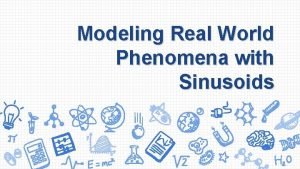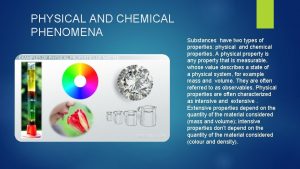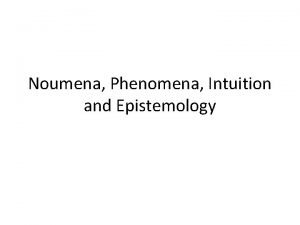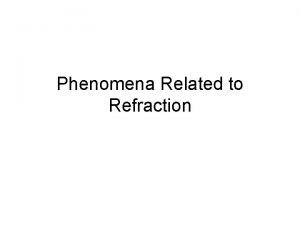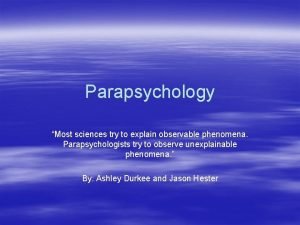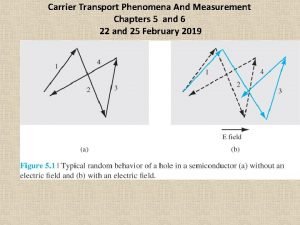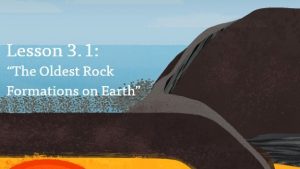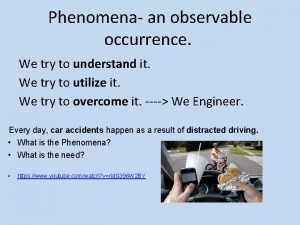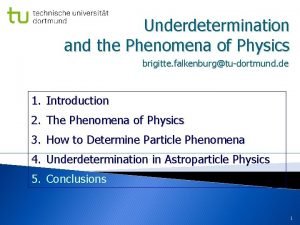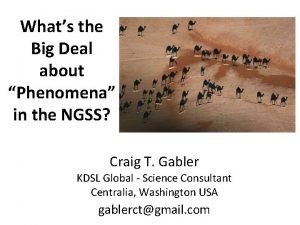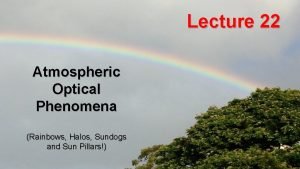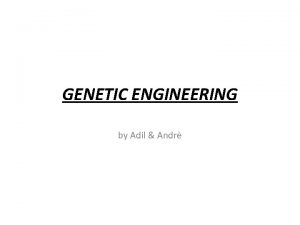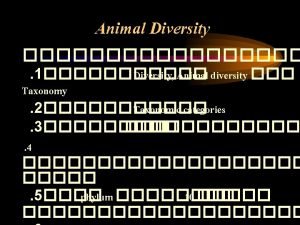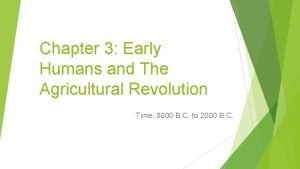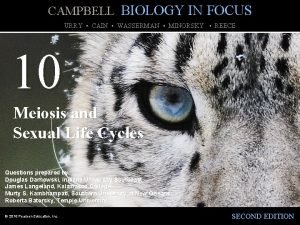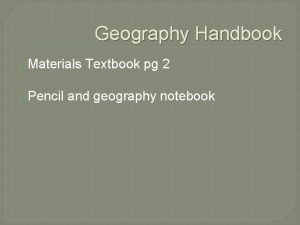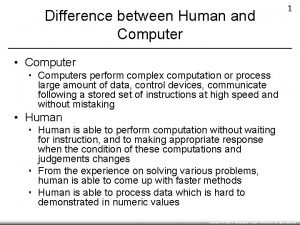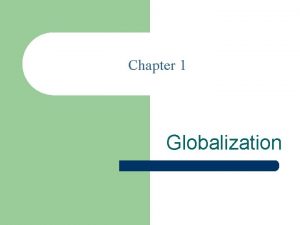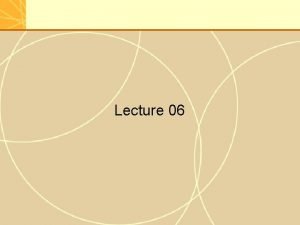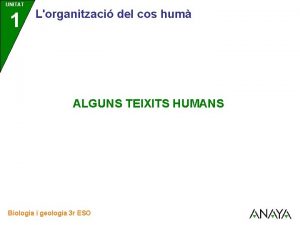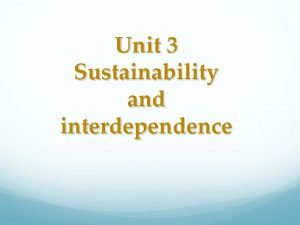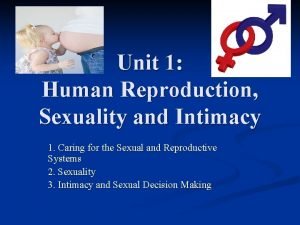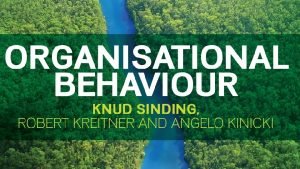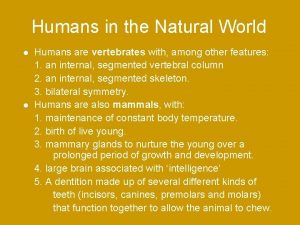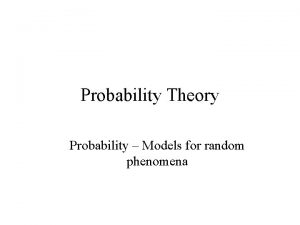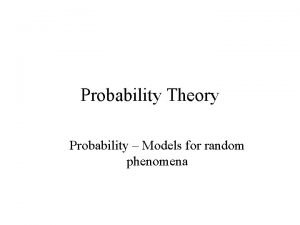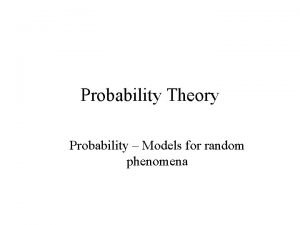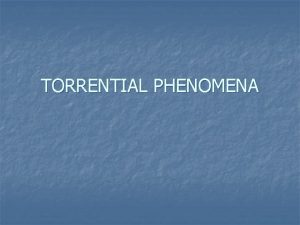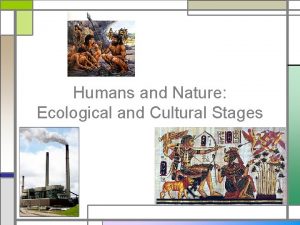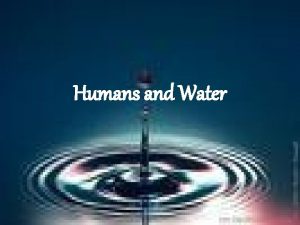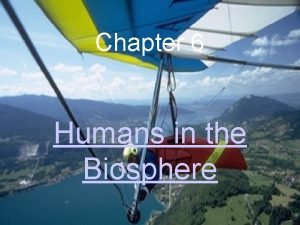Humans and the Natural World Natural phenomena Natural


























































































- Slides: 90

Humans and the Natural World Natural phenomena Natural hazard Disaster Catastrophe

Were these un-natural hazards? 1. FEMA balked at funding recovery from Texas fertilizer plant explosion? 2. Monday, at the Fukushima nuclear power plant, 300 tons of highly radioactive water leaked from one of more than 1, 000 emergency storage tanks? 3. Homes burned in Utah wildfires last week. 4. Give an example of your own.

Disaster – defined roughly as 10 or more dead, 100 or more people affected & disaster declaration for outside aid (p 3). Catastrophe – much more of the same, with long recovery, often years. The trend is for hazards to become disasters, and for disasters to become catastrophes.

**The book uses statistics that apply back and forth to the U. S. A. or the world, to the past and/or to trends. Potentially confusing. We won’t worry too much about that. Just keep in mind that atmospheric heat is now considered the emerging #1 cause of human deaths.

We must also distinguish between financial loss and human death or injury. In general, death rates are going down even as population is rising in hazardous areas. Financial losses are rising rapidly.

Why? More people have more stuff. More people with more stuff are moving to cool places that are also hazardous. As of 2013, 40% of U. S. population now lives in a coastal county.

The good news is that it’s mostly about money. People can usually scramble out of the way, but our ‘stuff’ usually can’t. . and we have a lot more ‘stuff’. Deaths Financial cost

The bad news is that it’s not about money if its you or me who gets hurt or killed. We get used to hearing of death counts, or that the injured will ‘recover’. Many injured people never really recover – Josef Stalin said: “A death is a tragedy. A million deaths is a statistic. ”

What about post-trauma stress? How do we measure lost productivity, long-term mental health problems and distraction caused by human failure to prevent needless disasters?

Direct effects are often processed statistically. Indirect effects can be much worse in total and are seldom reported accurately. The news media moves on to something more immediate, direct and concrete, while survivors deal with the long-term realities.

An Example: 2010 Haiti Earthquake – 7. 0 magnitude Caribbean Sea Source: NOAA Satellite and Information Service

Haiti Island in the Caribbean • • High population density Lack of adequate construction standards Inadequate disaster response capacity Lack of social infrastructure Lack of community and personal resources Rain shadow location Steep terrain, deforestation, severe weather, seismic activity, tropical biota (SLC for air quality) (inc. rebar) (compare to upwind Dominican Republic) (disease, pests, decay)

Haiti – building damage Source: Digital lobe, 2010

This building actually had rebar Source: ec. europa. eu @ google. com/imgres

Earth Circle Spheroid Oblate Spheroid Lumpy, Oblate Spheroid

Humans live in between two gigantic sources of energy: - radioactivity from the sun - radioactivity from deep inside the earth. Both forms of radioactivity produce heat. Heat sustains life and threatens life.

Think of a lava lamp

Earth - atmosphere is only 100 miles thick - dry crust is only about 50 miles thick (molten below) - both are moving convectively

Molten ball of fire Just beneath our feet

Plane of Ecliptic Earth axis is not perpendicular June 20 – longest day of the year Where? What is the shortest day? This tilted axis creates a continual shift in where solar energy is strongest - - changing seasons and weather.

Source: commons. wikimedia. org – Earthlighting-summer-solstice EN. png

Source: www. astronomy. org

Earth coordinates Latitude = Y axis (“up” and “down”) Longitude measures east-west X axis Source: worldwind. arc. nasa. gov

Time Zones longitude – x axis – east/west What time is it in Baghdad? (45 degrees East) Who got Monday first, China or Hawaii? How many miles are there in a time zone: - at the equator? - near the poles? What is the diameter of a spheroid 21, 000 miles in circumference? What is pi (π) when a diameter is 10, 000 miles?

Earth Dimensions • Diameter = D – distance through the middle • Circumference = C – distance around the circle • Pi = π = a standard, fixed, constant relationship between C and D D = 7, 923 miles -- about 8, 000 miles C = 24, 900 miles -- about 24, 000 miles π = 3. 1415868. . . -- about 3. 0

So. . C=πx. D D=C/π π=C/D 24 = 3 x 8 8 = 24/3 3 = 24/8 24 hours in a day – 24 time zones 360 degrees in a circle – 15 degrees per time zone. The Earth turns 15 degrees per hour. At the equator, each time zone spans 1, 000 miles.

World Time Zones Did the Soviets ‘cheat’ on getting 11 times zones? Alaskan islands extend westward enough to go into the eastern ‘half’ of the globe. Did the Chinese get ‘shorted’ by having only one time zone?

Natural Hazards • • Earthquakes, Tsunamis and other water waves Volcanoes Flooding Mass Wasting Subsidence and Soils Tornadoes, Hurricanes and cyclones Coastal Hazards & Climate change Extra-terrestrial (impacts & extinctions)

Earth Temperature With an atmosphere (ocean of air) average Earth temperature of water and air is 59 degrees F. Without an atmosphere, average Earth temperature would be 5 degrees F. Variations would go from +140 degrees and -102 degrees to +250 degrees and -200 degrees.

Climate is the sum of all weather across time. Climate cannot predict the weather. World average annual temperature: 59°F Lima, Ohio, annual average temperature: 59°F Lima, Peru, annual average temperature: 59°F

Without atmosphere With atmosphere What is average annual difference in temperature with or without an atmosphere? Without atmosphere, Earth would average 5 degrees F.

All of the Earth’s Surface has Hazards In a sense, there is no hazard if no one is there to experience it. Animals don’t usually get hurt by hazards because: - they usually don’t live where they shouldn’t; - they are adapted to moving and adjusting; - They don’t have any possessions.

In most cases, natural hazards are either created outright or made worse by human activity. That is one reason why no place on earth is free of hazards. (Of course, a meteorite can strike anywhere and humans don’t cause those. )

Planning, Predicting and Forecasting Humans are unique – consciousness, imagination, understanding Animals are more intuitive and reactive. Locusts, coyotes and rabbits just do what they do. There is no “off switch” in their consumption. With all of our awareness and talent, can humans learn to do better than animals?

Risk – the probability of an event multiplied by the consequence of the event. The probability of an event is inversely related to its consequence. (the bigger the event the less often it occurs).

Outlook - A generalized view of the future (like Farmer’s Almanac) Forecast – more specific expectation – trends, spoken as probability, percent (%), statistics or ranges of time and place Prediction – is about date, time, place and magnitude of the event Planning-- Learning from the past, anticipating hazards and preparing for them WFRC emergency prep plan, and annual “Shake Out” events) (

Precursor (an actual event that is linked to the “main event”) Outlook (Look out! That hillside is going to slide. ) Forecast (That hillside will probably slide with the next heavy rain) Prediction Seldom possible (That hillside will slide at 10: 00 AM tomorrow) Watch (The conditions are perfect – start watching) Warning (Someone reported seeing rocks start to move)

Notice that this chart is for number of events, not money losses or deaths. More people, and/or more people living in hazardous places? Probably both. Do humans control quakes? Wickedness?

Trends Weather and climate are always changing – recent decades suggest yet another warming trend -- more warmth, more dryness – more drought. World average annual temperatures started rising before humans had any effect – our likely effect now is that we are adding further warmth, mostly by burning fossil fuels.

Is it the heat from combustion or the gases that cause atmospheric warming? Exhaust pipe heat is less important than exhaust pipe gases that retain solar heat. The latest National Geographic confirmed what a student in my class reported this Spring: Atmospheric carbon dioxide has reached 400 ppm after thousands of years at about 280 ppm.

World Population Tops 7. 0 Billion 100, 000 power plants 1. 5 billion automobiles 1. 0 billion livestock Half of all humans now live in cities – concentration of effects at some of the worst possible locations.

The best hope for prevention of disasters. . . is education

Sustainability (banned in Utah in 1980 s) Using natural resources in such a way as to not diminish the ability of future generations to do the same. What about financial resources? U. S. Federal budget deficit exceeds $17 B. FEMA is broke (FEMA induced to pay for the Texas fertilizer plant explosion even though it was not a natural disaster). Katrina cost $130 B Super Storm Sandy cost $55 B (so far) What is the “carrying capacity” of a site or location or region?

Which is the most hazardous to people? Flooding has been the most commonly experienced natural hazard, but ‘heat waves’ is likely the biggest ‘killer’ in the future, particularly going forward. Heat is probably now the biggest killer. Also, we take for granted protecting ourselves from cold weather, but the hazard is still very real.

Example: Climate is not average weather What is the average of a tornado and a sunny day? Florida: Climate is what you bought; weather is what you got. What is the difference between prediction and forecast?

Climograph Source: shannonmapcatalog. blogspot. com

Source: aronhotalen. blogspot. com

So. . What would our climograph look like?

Salt Lake area climograph Source: www. usweatherdata. com

Chapter 2 Internal Earth Structure Source: rationalskepticism-forumblogspot. com

Sources of Earth Heat • Radiation from the Sun • Radioactive decay from inside the Earth Both involve radioactivity – Nuclear energy is nature’s way So, was the Fukushima nuclear power plant failure a natural disaster or not? How would FEMA rules apply?

Four Types of Earth-Ocean Interaction - Land up - Land down - Ocean up - Ocean down Caused mostly earth radioactivity tectonics Caused mostly by solar radioactivity - climate

Earth Crust Profile Source: www. sciencedaily. com

Crust varies in thickness It’s OK to think of it being about 50 miles thick, or roughly half the thickness of the atmosphere, and varying widely from one mile to 200 miles in thickness.

Asthenosphere Lava Lamp Dry, brittle crust at the top. In between, just under the crust, the asthenosphere is relieved of enough pressure to move, and still hot enough to flow convectively. Compressed, heavy, solid at the center. Source: www. giantbomb. com

Earth Plates (tectonics) Source: windowstouniverse. org

Source: www. enchantedlearning. com

Pacific Plate & North American Plate Los Angeles is going to San Francisco and then on to Alaska Source: Wikimedia Commons

Seismology The study of earthquakes and seismic waves – energy transferred by conduction -energy just passing through – like a slinky – the metal does move, but only locally. Ripples in a pond for a stone thrown.

Convection, Subduction, Divergence, Convergence, Transform Source: joelcayford. blogspot. com

Dry continental crusts are slightly lighter than crusts under the ocean, so they ‘float’ a little higher. Collisions mean that the heavier crust tends to subduct (slide below) the continental crust.

Ridge Push Slab Pull Source: wikipedia. org/wiki/Convection

Convective Flow Source: wikipedia. org/wiki/Convection

Indian Subcontinent uplift convergence

Plate Motion is a Fast Process? - About ½ inch per year in many places - More than two inches per year in other places Northern hemisphere crust is rebounding after recent ice age, at about 0. 4 inches per year. North America and Europe are diverging at about 0. 5 inch per year.

Consider four important kinds of “cracks” in the crust: 1. “Hot Spots” 2. Subduction (convergence) zones 3. Divergence zones (new crust) 4. The “Ring of Fire”

Two special volcanic “Hot Spots” Hawaiian Islands & Yellowstone Park


Yellowstone Caldera



Ring of Fire – Ring of Volcanoes Ring of Buildings -- Ring of People -- Ring of Gamblers

Pacific Ring of. . Quakes Tectonic forces produces crustal movement Quakes, volcanoes, tsunami waves Rapid human population growth along 22, 000 mile Pacific Rim – economic “tigers” 40% of US population now living in coastal counties (east, west and south, and lakes) Much of Pacific Rim population lives near the coast. World’s largest gambling center may be Hainan Island, not Las Vegas – ring of Gamblers (and winners? )

So, consider an axiom: Natural Hazards don’t kill people. . . buildings kill people. 1. The 2012 Russian meteorite killed no one, but 2, 500 people were injured by broken glass 2. The 1906 San Francisco earthquake killed few people outright – building fires killed thousands.

The textbook says most quake deaths are from building failure – human caused? Millions of people are moving to the “Pacific Rim” which is almost exactly the same as the “Ring of Fire. ” So. .

Why not call the “Ring of Fire” - the ring of people? - the ring of buildings for people? - the ring of gamblers in buildings? - the ring of. . . gambling idiots in buildings?

U. S Earthquake Hazard The United States has a portion of the “Ring of Fire” -- millions of people are there - - and more coming.

Quake Schematic Fault or fracture Hypocenter

On a regional scale – plate boundaries Divergent Convergent Uplift (converging) Subduction (converging) Transform Rift (divergent)

On a Local Scale - Faults Block – dip slip – mostly vertical Slip-Strike or Transform – mostly horizontal Over-thrust – angled one moving over the other

Quake Energy vs Quake Movement The old “Richter” scale – energy released – exponential (logarithmic) base = 32 Moment magnitude and Richter are roughly equal so we just say “M” for magnitude Magnitude For energy released: For earth movement or shaking: 1. 0 2. 0 5. 0 6. 0 3. 0 5. 0 8. 0 32 x 32 = 1, 000 32 x 32 = 33, 000 10 x 10 = 100 10 x 10 = 1, 000 1. 1 1. 0 1. 2 40% more energy 100% more (double) the energy

Quake Energy Release 1. 0 1. 2 = double (2 x) 1. 2 1. 4 = 2 x 1. 4 1. 6 = 2 x 1. 6 1. 8 = 2 x 1. 8 2. 0 = 2 x 4. 0 5. 0 = 2 x 2 x 2 = 25 = 32 x

Comparing quakes 3. 2 4. 9 = how much more energy released? 3. 2 4. 2 = 32 x 4. 2 4. 4 = 2 x (double) 4. 2 4. 6 = 2 x 2 (4 x or four times more) 4. 2 4. 8 = 2 x 2 (8 x or eight times more) 4. 8 4. 9 = 40 percent more (1. 4 x) 8. 0 x 1. 4 x 32 = 358. 4 times more energy released

Another Example Fukushima – M 9. 1 in 2011 vs Utah’s Largest Recorded Quake – M 6. 3 in 1934

6. 3 9. 1 6. 3 7. 3 = 32 x 7. 3 8. 3 = 32 x 8. 3 8. 5 = 2 x 8. 5 8. 7 = 2 x 8. 7 8. 9 = 2 x 8. 9 9. 1 = 2 x 32 x 24 = 32 x 16 = 16, 384 times larger Or 6. 3 7. 3 = 32 x 7. 3 8. 3 = 32 x 8. 3 9. 3 = 32 x Minus 0. 2 (half instead of double) 32 x 0. 5 = 16, 384 times larger

A four-foot vertical break or fracture was discovered somewhere on the Salt Lake bench. How does that compare to the 65 -foot break in the Sumatran quake of 2004? <the Sumatran fault movement was not 16, 384 times bigger than the Salt Lake fault movement -- energy release is not equal to ground shaking>

Modified Mercalli Quake Scale A composite score or estimated magnitude based on: - Instrument intensity - Observations of effects May take weeks to compile, including interviews, newspaper articles, measurements of bent metal, cracks in the Earth, etc.

Earthquake Shock – Movement – energy transfer P wave – primary, compressional – 3. 7 mi/sec = 13, 320 mph Compare to speed of sound – 750 mph, space shuttle 17, 500 mph, bullet 3, 000 mph Secondary – S wave – side-to-side whipping – slower - 1. 9 miles/sec Surface wave – energy reaches the atmosphere – ground or surface waves rolling in complex ways – can shake the air enough to create a sonic, or sound wave (like ECenter area in 1983) Twisting movement can really damage buildings – bronco Factors affecting actual damage:

Factors Affecting Quake Effects Water in soil Time of day Building height (more movement with height) Building strength – wood vs metal vs masonry vs unreinforced earth mass Slope Bedrock, soil, alluvium Later distance from epicenter Depth (distance to surface) Magnitude Type of fault – block, transform

Triangulation Angle – geometry – find the junction of differing reports – side, side -- angle, angle Time – 50 second delay between P and S waves = 260 miles Zero time delay between them = epicenter
 Sinusoidal function examples in real life
Sinusoidal function examples in real life Natural phenomena ppt
Natural phenomena ppt Physical and chemical phenomena
Physical and chemical phenomena Which are not purely surface phenomena
Which are not purely surface phenomena Surface and interfacial phenomena
Surface and interfacial phenomena Noumena and phenomena
Noumena and phenomena A moose monikko
A moose monikko Phenomena related to refraction
Phenomena related to refraction Observable phenomena
Observable phenomena Objective phenomena
Objective phenomena Natural language processing
Natural language processing Reference phenomenon in nlp
Reference phenomenon in nlp Gravitation is a natural phenomenon where:
Gravitation is a natural phenomenon where: Carrier transport phenomena
Carrier transport phenomena Anchor phenomenon
Anchor phenomenon Observable phenomena meaning
Observable phenomena meaning Reoulox phenomena
Reoulox phenomena Global climate phenomena
Global climate phenomena Random phenomena
Random phenomena Brigitte falkenburg
Brigitte falkenburg Slide todoc.com
Slide todoc.com Hypnotic phenomena
Hypnotic phenomena Noumena vs phenomena
Noumena vs phenomena Refraction phenomena
Refraction phenomena A rainbow is an optical display
A rainbow is an optical display Noumena vs phenomena
Noumena vs phenomena Hình ảnh bộ gõ cơ thể búng tay
Hình ảnh bộ gõ cơ thể búng tay Frameset trong html5
Frameset trong html5 Bổ thể
Bổ thể Tỉ lệ cơ thể trẻ em
Tỉ lệ cơ thể trẻ em Gấu đi như thế nào
Gấu đi như thế nào Tư thế worms-breton
Tư thế worms-breton Hát lên người ơi
Hát lên người ơi Môn thể thao bắt đầu bằng từ chạy
Môn thể thao bắt đầu bằng từ chạy Thế nào là hệ số cao nhất
Thế nào là hệ số cao nhất Các châu lục và đại dương trên thế giới
Các châu lục và đại dương trên thế giới Công của trọng lực
Công của trọng lực Trời xanh đây là của chúng ta thể thơ
Trời xanh đây là của chúng ta thể thơ Mật thư anh em như thể tay chân
Mật thư anh em như thể tay chân Phép trừ bù
Phép trừ bù Phản ứng thế ankan
Phản ứng thế ankan Các châu lục và đại dương trên thế giới
Các châu lục và đại dương trên thế giới Thể thơ truyền thống
Thể thơ truyền thống Quá trình desamine hóa có thể tạo ra
Quá trình desamine hóa có thể tạo ra Một số thể thơ truyền thống
Một số thể thơ truyền thống Cái miệng nó xinh thế chỉ nói điều hay thôi
Cái miệng nó xinh thế chỉ nói điều hay thôi Vẽ hình chiếu vuông góc của vật thể sau
Vẽ hình chiếu vuông góc của vật thể sau Biện pháp chống mỏi cơ
Biện pháp chống mỏi cơ đặc điểm cơ thể của người tối cổ
đặc điểm cơ thể của người tối cổ V cc cc
V cc cc Vẽ hình chiếu đứng bằng cạnh của vật thể
Vẽ hình chiếu đứng bằng cạnh của vật thể Vẽ hình chiếu vuông góc của vật thể sau
Vẽ hình chiếu vuông góc của vật thể sau Thẻ vin
Thẻ vin đại từ thay thế
đại từ thay thế điện thế nghỉ
điện thế nghỉ Tư thế ngồi viết
Tư thế ngồi viết Diễn thế sinh thái là
Diễn thế sinh thái là Dot
Dot Số nguyên tố là
Số nguyên tố là Tư thế ngồi viết
Tư thế ngồi viết Lời thề hippocrates
Lời thề hippocrates Thiếu nhi thế giới liên hoan
Thiếu nhi thế giới liên hoan ưu thế lai là gì
ưu thế lai là gì Hổ đẻ mỗi lứa mấy con
Hổ đẻ mỗi lứa mấy con Sự nuôi và dạy con của hươu
Sự nuôi và dạy con của hươu Hệ hô hấp
Hệ hô hấp Từ ngữ thể hiện lòng nhân hậu
Từ ngữ thể hiện lòng nhân hậu Thế nào là mạng điện lắp đặt kiểu nổi
Thế nào là mạng điện lắp đặt kiểu nổi Pro genetic engineering
Pro genetic engineering A sexual reproduction
A sexual reproduction Pros and cons of biotechnology
Pros and cons of biotechnology All mammals have hair. its main purpose is to
All mammals have hair. its main purpose is to Chapter 3 early humans and the agricultural revolution
Chapter 3 early humans and the agricultural revolution Privet shrubs and humans each have a diploid number of 46
Privet shrubs and humans each have a diploid number of 46 Privet shrubs and humans each have a diploid number of 46
Privet shrubs and humans each have a diploid number of 46 What is the relationship between humans and the environment
What is the relationship between humans and the environment Early humans and the agricultural revolution answer key
Early humans and the agricultural revolution answer key 10 difference between human and computer
10 difference between human and computer Ap world history chapter 25 africa and the atlantic world
Ap world history chapter 25 africa and the atlantic world The changing world output and world trade picture
The changing world output and world trade picture The changing world output and world trade picture
The changing world output and world trade picture Introduction of transport
Introduction of transport Teixits humans
Teixits humans Effects of inbreeding in humans pictures
Effects of inbreeding in humans pictures The first human on earth
The first human on earth A sexual reproduction in humans
A sexual reproduction in humans 23 chromosome pairs
23 chromosome pairs Family genus species order
Family genus species order Parasitism
Parasitism Three types of mutualism
Three types of mutualism How humans behave in organisations
How humans behave in organisations
